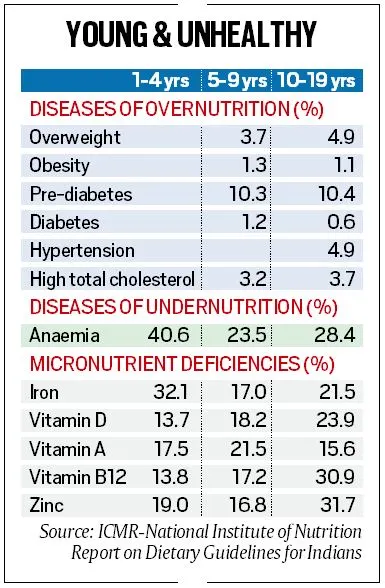With noncommunicable diseases (NCDs) — cardiovascular disease, cancers, diabetes, etc. — rising, and affecting adolescents and even children, India’s premier nutrition research institute has published comprehensive guidelines on the diet of vulnerable groups, including pregnant and lactating women, and children and the elderly.

The guidelines say an estimated 56.4% of India’s total disease burden can be attributed to unhealthy diets. A healthy diet and physical activity can prevent 80% of Type 2 diabetes cases, and significantly reduce the burden of heart disease and high blood pressure.
Focus on children, mothers
Optimal nutrition for mother and child from conception till the age of 2 years is linked to proper growth and development. It can prevent all forms of undernutrition, including micronutrient deficiencies, and obesity.
The report quotes the Comprehensive National Nutrition Survey 2019, which showed high prevalence of lifestyle conditions even in children. Around 5% of children of ages 5-9, and 6% of adolescents, were overweight or obese, almost 2% of children and adolescents were found to have diabetes, and another 10% had pre-diabetes.
The survey found high levels of bad cholesterol (LDL and triglycerides) in 37.3% of children ages 5-9, and 19.9% of pre-teens and teens ages 10-19. Levels of good cholesterol were low in a fourth of all children and adolescents.
 ICMR report data.
ICMR report data.
Dual nutrition challenge
Incidence of micronutrient (zinc, iron, vitamins) deficiencies ranged from 13% to 30% of children between ages 1 and 19. The recommended ideal diet charts for various groups of people takes into account both micronutrient deficiencies and diseases of overnutrition.
Story continues below this ad
While severe forms of undernutrition such as marasmus (a deficiency of macronutrients such as carbohydrates and proteins) and kwashiorkor (deficiency of proteins) have disappeared from the country, manifestations such as anaemia continue, the report says. It puts the prevalence of anaemia at 40.6%, 23.5%, and 28.4% in children under age 5, ages 5-9, and 10-19 respectively.
A study on malnutrition published in The Lancet earlier this year said undernutrition continues to be high in India, but obesity has increased significantly over the last 30 years.
The “faulty dietary pattern” in which unhealthy, highly processed, high-fat, sugar and salt (HFSS) foods have become more affordable and accessible than healthier alternatives, “contributes to deficiencies in iron and folic acid, resulting in anaemia and in the higher prevalence of overweight and obesity among population groups,” the report says.
General dietary principles
The guidelines recommend getting required nutrients from at least eight food groups, including vegetables, leafy vegetables, roots and tubers, dairy, nuts, and oils. Consumption of cereals — the staple of Indian meals — should be restricted, so they contribute only 45% of the total energy (instead of the 50-70% now. Instead, more proteins (pulses, meat, poultry, fish) should be consumed, making up 14% of the total daily energy (instead of only 6-9% now).
Story continues below this ad
Achieving adequate levels of essential polyunsaturated fatty acids (PUFA) and B12 is a challenge for vegetarians. The guidelines recommend consumption of flax seeds, chia seeds, walnuts, vegetables, and greens.
The report says salt consumption should be restricted to 5g a day, and strongly recommends against consuming highly processed foods that are typically high in fats, salt, sugar.
Group-specific guidelines
Pregnant women: Small frequent meals for those experiencing nausea and vomiting. The guidelines recommend consumption of lots of fruit and vegetables, especially those high in iron and folate content.
Infants and children: For the first six months, infants should only be breastfed, and must not be given honey, glucose, or diluted milk. There is no need to give water, even during hot months. After age 6 months, complementary foods must be included.
Story continues below this ad
Elderly: The elderly should consume foods rich in proteins, calcium, micronutrients, and fibre. Apart from pulses and cereals — with at least one-third as whole grains — at least 200-400 ml of low-fat milk or milk products, a fist full of nuts and oilseeds, and 400-500g of vegetables and fruit should be consumed. Exercise is important in order to maintain bone density and muscle mass.



 ICMR report data.
ICMR report data.




































